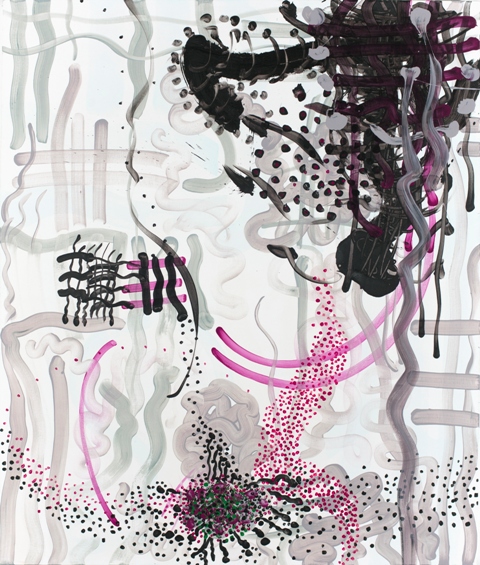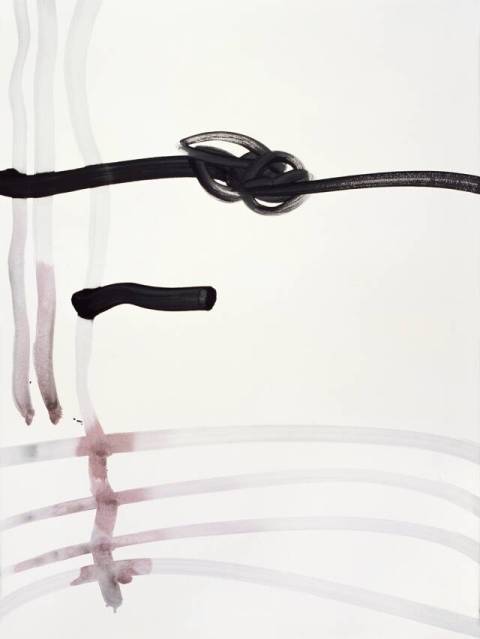
Peter Wayne Lewis, born in Jamaica, living and working in the US.
Monk Time, 2013.
“I am from Jamaica, a Caribbean melting pot. I came to the United States when I was nine years old and, after forty-five years, I still do not have a sense of being at home even though I have become an American citizen. I’m still trying to find a balance. When I create, this becomes reflected in an uncomfortable formal balance. Being an immigrant is crucial because it determines how one thinks about stability. It’s the imbalance that creates the tension in the work. I have an understanding of imbalance – this adds psychological charge to the work, which makes it human. Throughout my travels as an artist, I have visited many countries, including Senegal, Germany, France, Italy, Czech-Republic, Cuba, Panama, Japan and, over the last four years, China. My migration has led me to leasing a studio space in Beijing. The contemporary Chinese art scene has exploded on the world stage and I wanted to bear witness to it as an artist and educator.
 Purple Mania, 2010.
Purple Mania, 2010.
Painting is a ritual act. I’m trying to discover a link to the spiritual. I aim to transcend the flesh. Ritual describes something greater than it is. It becomes a connection to intangible things, the realm of the spiritual. For me a ritual act is a bridge to different sorts of experiences. The shaman bridges the realms of flesh and spirit to bring back knowledge that can be shared. My religious beliefs are akin to those of the shaman. I am devoted to making these pictures. I don’t want my paintings to be passive objects. I want them to generate excitement, questioning, even intrigue. Some perceived imbalance or discord allows movement and rhythm.
 Gecko’s Tail, 2013.
Gecko’s Tail, 2013.
I’m very conscious of the formal attributes. I teach those compositional elements of formal balance, harmony, and unity. Personally, I’m trying to shake that up in my work. I’m trying to find other ways of creating harmony, ways that generate some uneasiness. We are formed in darkness and born into the light. There is a metaphorical structure in the work. I do not present a mimetic structure. The picture suggests images of the natural world: trees, sky, and earth. I can’t deny that. But I’m not consciously painting things I see. I’m interested in the phenomenon of the horizon that separates the opaque earth from the transparent sky. I paint primarily at night. There is a different presence of light, the nocturnal energy – a different kind of stillness.
 Beijing Booster 619, 2009.
Beijing Booster 619, 2009.
I’m interested in graceful Chinese calligraphy and Japanese sumi ink paintings. It was interesting to be introduced to the work of the master painter, Ba Da Shan Ren (1626-1705) of China, during my painting session in Beijing last year. I saw parallel pictorial relationships between his work and mine. This is the beauty and education of travel. There’s an idea in string theory that we exist as strings. We’re vibrating strings. This idea links physics to my great love, music. According to string theory, if we could magnify a point, we would actually see a vibrating string. Matter is a series of points, not unlike a strand of DNA. The vibration of the strings creates harmony. The laws of physics can be compared to the laws of harmony. The universe can be compared to countless vibrating strings. The universe is a symphony of color and light. In 1982 I traveled with my wife, Catherine, to Europe. We went to see the pre-historic cave paintings at Lascaux. I think of these caves, demarcated by the stalagmites and stalactites, as earth’s first Gothic cathedrals. I had a pretty profound experience.
 Automatic Model, 2009.
Automatic Model, 2009.
I was overwhelmed. I started thinking about architecture, ritual space, the animals, and things that threaten us. I cried. Those paintings altered what I was doing. I’ve always been interested in building images that move people in similar ways. I have a great love for the materiality of paint - the tactile sensation, scarification of the paint, that writhing, dancing movement of the pigmented mud. There’s a comfortable melding between my sensibility and paint. My body feels it. It makes sense for me. My choice to paint the unknown hopefully leads to some sort of resonance, something of permanent value. I strive to present reflections of my collective inner-world. They are not meant to inform, but to transform. Ultimately, the paintings live and die in the eyes of the viewer. “
